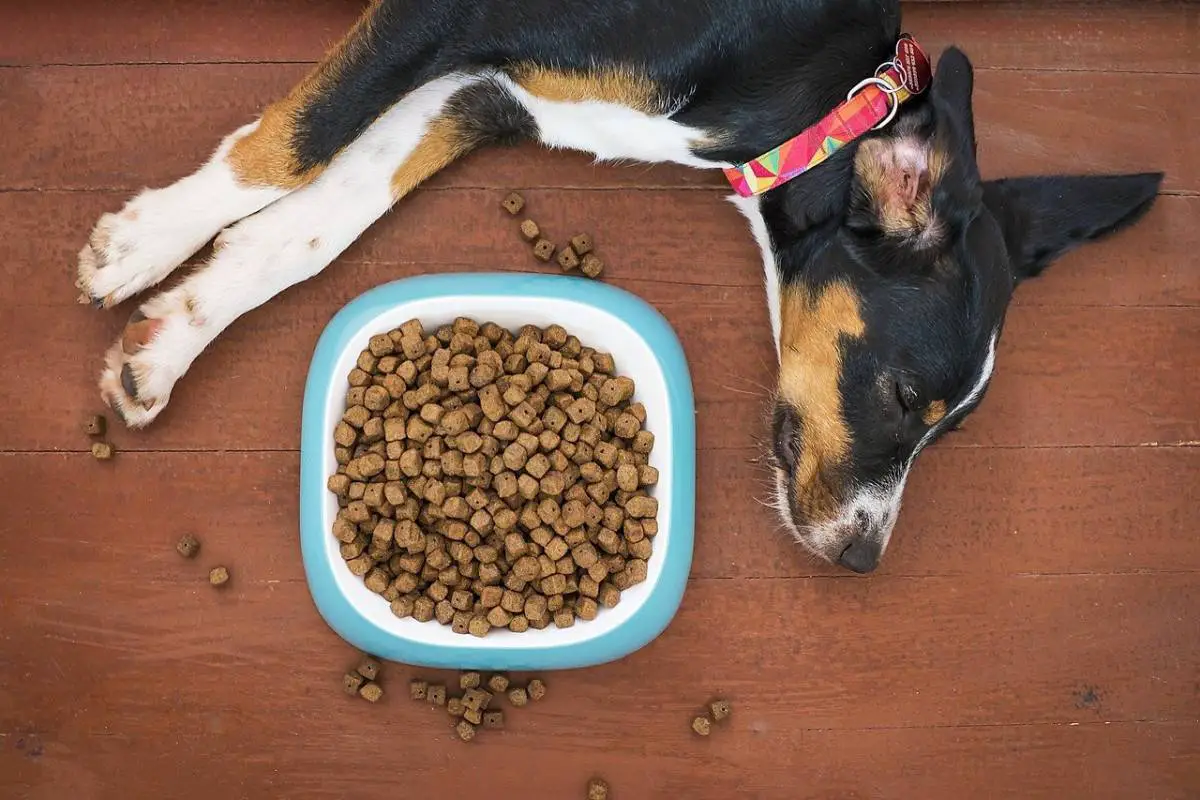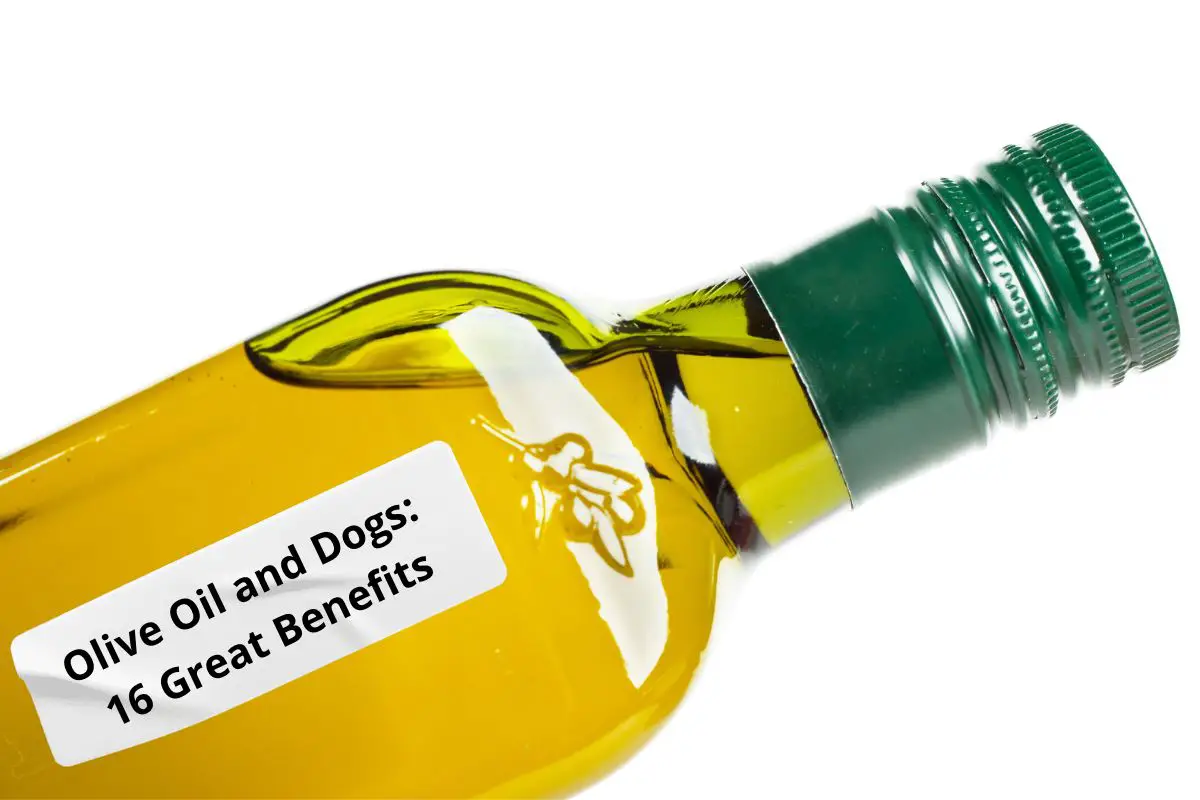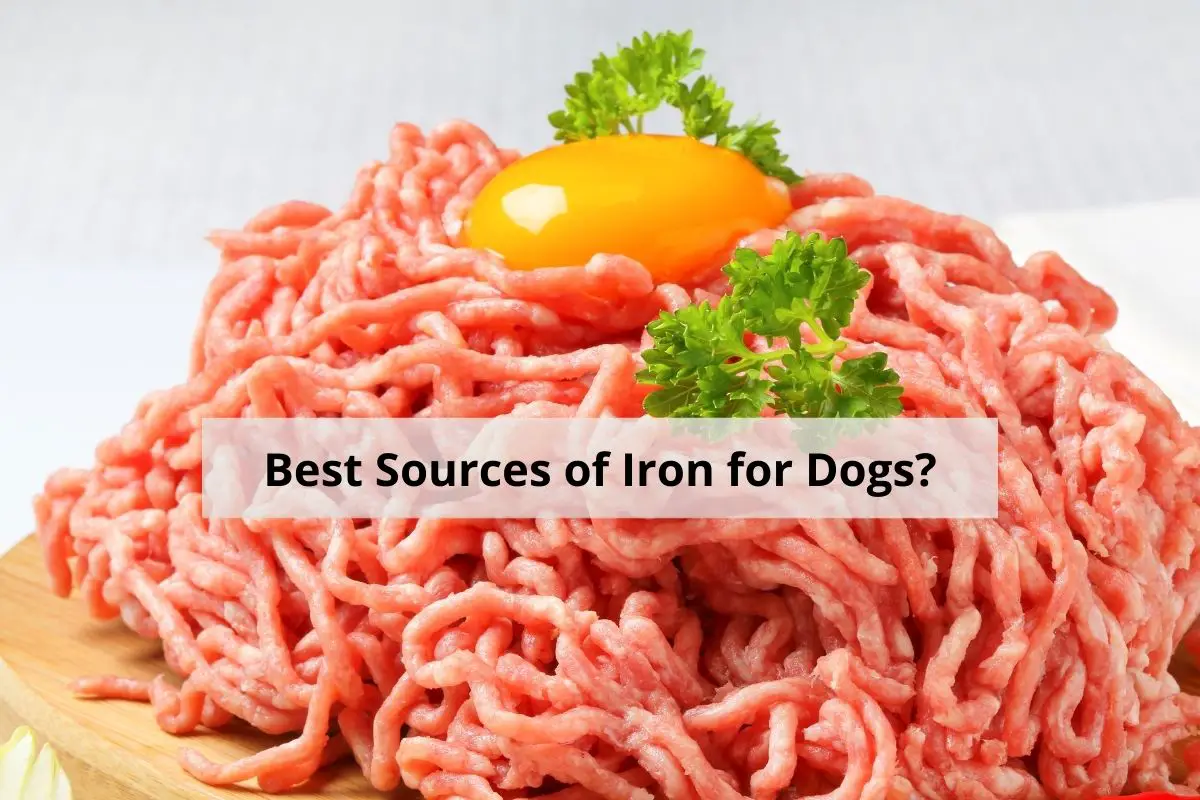This post contains affiliate links.
Mixing wet and dry dog food can be a little hard to figure out at first. If you want to support a healthy weight on your dog, how you mix wet and dry dog food will matter. It’s important to stay within the recommended serving size for the food you buy.
The ratio you should mix wet and dry dog food depends on which medium you want more of or serve it 50/50. A single 3 oz – 3.5 oz can of wet food is roughly equivalent to 1/4 cup of dry dog food. A 12.5 oz can is roughly equivalent to 1 1/4 cups of dry food.
|
Dog Size |
Wet Food |
Dry Food |
Total Daily Serving |
|
3-12 lbs |
3 oz can |
Dash to ¾ cup |
⅓ to 1 cup |
|
13-20 lbs |
3 oz can |
¾ to 1 cup |
1 to 1 ⅓ cups |
|
21-35 lbs |
3 oz can |
1 to 1 ¾ cups |
1 ⅓ to 2 cups |
|
26-50 lbs |
6 oz (2 cans) |
1 ½ to 2 ⅙ cups |
2 to 2 ⅔ cups |
|
51-75 lbs |
6 oz (2 cans) |
2 ⅙ to 2 ⅘ cups |
2 ⅔ cup to 3 ⅓ cups |
|
76-100 lbs |
10 oz |
2 ⅓ to 3 ¼ cups |
3 ⅓ to 4 ¼ cups |
|
Over 100 lbs. |
10 oz |
3 ¼ + ¼ per 10 lbs |
4 ¼ + ¼ per 10 lbs |
To further explain mixing wet and dry dog food, other potential serving ratios read through this article.
Table of Contents
Basic Nutritional Information
Understanding how you should mix wet and dry dog food helps to know the nutritional information for both. A dog can digest both, and one isn’t better than the other, according to the VCA Hospital.
The main reasons for mixing wet and dry food will vary depending on your dog and their health needs. If your dog loves dry kibble and is getting plenty of water, there’s no need to mix wet and dry foods.
For continuity in this article, all references to calories (kcal) and serving sizes will be based upon the Blue Buffalo Life Protection Formula for Healthy Weight Adult Dog Food, in Chicken and Brown Rice flavor. Here is a link for dry food and a link for wet food.
Before you start a wet and dry food mix, double-check the serving size for the food you already give your dog or plan to give your dog. Slight adjustments may be needed.
Calories and Serving Sizes
When mixing wet and dry dog food, it’s important to keep a ratio within the recommended calories for your dog. The calories that your dog needs are based on breed, weight, age, and activity level.
For example, a large breed dog requires a food catered to large breeds, but this dog is also overweight. In which case, you will want to serve 70% of the suggested serving on your dog food label.
To get an estimate on the number of calories your dog needs to take-in daily, check out the Dog Food Calculator on Dog Food Advisor. After typing in your dog’s ideal weight, activity level, and the kcal/cup of your dog food. The calculator provides the suggested kcal/day and the cups/day of dog food.
A 65-pound dog who is overweight and eats food with 326 kcal/cup, needs 887 kcal/day and 2.72 cups/day. In dry food, this dog would get 1 ⅔ cups of dog kibble twice a day.
The serving size for the same dog who eats wet food at 354 kcal/cup is 887 kcal/day and 2.51cups/day. Split between 2 meals, it’s 1 ¼ cups of wet food at each serving.
Wet vs. Dry Ingredients
You might have noticed the serving size per day for our overweight dog is less in wet food versus dry food in the example above.
The wet food has a higher kcal/cup amount. This is in part to the fact that there’s more packed into less. Wet food is a condensed version of dry food. Per serving, canned dog food has a higher protein and fat level and a lower carbohydrate level.
Here are the percentages of protein, fat, and carbohydrates for both types of food:
|
Nutrient |
Dry Kibble |
Wet/Canned Food |
|
Protein |
18-32% |
28-50% |
|
Fat |
8-22% |
20-32% |
|
Carbohydrates |
46-74% |
18-57% |
Nutritionally, dogs can digest carbohydrates. The long-standing myth that dogs need to be carnivores isn’t true. Over the years of evolving to be a house pet, dogs have adjusted to being able to be omnivorous. Some grains in your dog’s food are fine, but not all dogs digest them and others. The VCA recommends feeding your dog the highest-quality food you can afford.
For this reason, dry kibble isn’t better or worse than wet canned food. Why you would want to mix dry and wet dog foods is discussed below.
Ratios and Servings
When you mix dry and wet dog food, it’s important to remember to keep the total kcal/day at your dog’s recommended level. For the 65-pound overweight dog, it’s 887kcal/day. It’s recommended to feed your dog twice a day, with each meal is no more than 443 kcal.
The recommended serving size on the label of dog food brands is listed in daily servings. You will want to split this in half for the serving amount at each meal.
Now, there’s no correct ratio for mixing wet and dry dog food. You can serve wetter than dry, more dry than wet, or 50% of each. What’s important is the amount of wet food to add and how much dry food to take away, not to exceed kcal/day.
Here is a simple conversion table based on the substitution amounts suggested by Purina:
|
Serving in Wet |
Serving in Dry |
|
3 oz can |
¼ cup |
|
12.5 oz can |
1 ¼ cups |
For every 3 oz. canned dog food, you need to take away ¼ cup of dry food. If you have a large dog, a 12.5 oz can is equivalent to 1 ¼ cups of dog food, and that amount needs to be subtracted.
To make it simple, find the table below with the ratio you prefer of wet to dry food (25:75, 50:50, or 75:25), and the serving amounts of each will be listed per size dog.
25:75 Ratio
|
Dog Size |
Wet Food |
Dry Food |
Total Daily Serving |
|
3-15 lbs |
¼ to ½ cup |
¼ to 1 cup |
½ to 1 ½ cups |
|
16-25 lbs |
½ cup |
1 to 1 ½ cups |
1 ½ to 2 cups |
|
26-40 lbs |
½ to ¾ cup |
1 ½ to 2 ¼ cups |
2 to 3 cups |
|
41-60 lbs |
¾ to 1 cup |
2 ¼ to 3 cups |
3 to 4 cups |
|
61-80 lbs |
1 to 1 ¼ cups |
3 to 3 ¾ cups |
4 to 5 cups |
|
81-100 lbs |
1 ¼ to 1 ½ cups |
3 ¾ to 4 ½ cups |
5 to 6 cups |
|
Over 100 lbs. |
1 ½ cups |
4 ½ + ½ per 20 lbs |
6 + ½ for every 20 lbs extra |
50:50 Ratio
|
Dog Size |
Wet Food |
Dry Food |
Total Daily Serving |
|
3-15 lbs |
¼ to ¾ cup |
¼ to ¾ cup |
½ to 1 ½ cups |
|
16-25 lbs |
¾ to 1 cup |
¾ to 1 cup |
1 ½ to 2 cups |
|
26-40 lbs |
1 to 1 ½ cups |
1 to 1 ½ cups |
2 to 3 cups |
|
41-60 lbs |
1 ½ to 2 cups |
1 ½ to 2 cups |
3 to 4 cups |
|
61-80 lbs |
2 to 2 ½ cups |
2 to 2 ½ cups |
4 to 5 cups |
|
81-100 lbs |
2 ½ to 3 cups |
2 ½ to 3 cups |
5 to 6 cups |
|
Over 100 lbs. |
3 cups |
3 + ½ per extra 20 lbs |
6 + ½ for every 20 lbs extra |
75:25 Ratio
|
Dog Size |
Wet Food |
Dry Food |
Total Daily Serving |
|
3-15 lbs |
½ to 1 cup |
up to ½ cup |
½ to 1 ½ cups |
|
16-25 lbs |
1 to 1 ½ cups |
up to ½ cup |
1 ½ to 2 cups |
|
26-40 lbs |
1 ½ to 2 ¼ cups |
½ to ¾ cup |
2 to 3 cups |
|
41-60 lbs |
2 ¼ to 3 cups |
¾ to 1 cup |
3 to 4 cups |
|
61-80 lbs |
3 to 3 ¾ cups |
1 to 1 ¼ cups |
4 to 5 cups |
|
81-100 lbs |
3 ¾ to 4 ½ cups |
1 ¼ to 1 ½ cups |
5 to 6 cups |
|
Over 100 lbs. |
4 ½ cups |
1 ½ + ½ for every 20 lbs |
6 + ½ for every 20 lbs extra |
It does get tricky when you need to adhere to a strict kcal/day diet like the example of the overweight adult dog. For this, keep the substitution conversions in mind. The Blue Buffalo dry food is 326 kcal/cup. To meet the 443 kcal/serving requirement, this dog needs roughly 1 ⅓ cups of dry dog food per meal.
If you want to mix dry and wet food, start by replacing ¼ cup of dry food with a 3 oz. can of wet food. Remember that wet food is slightly higher kcal/cup, but the extra 20kcal/cup isn’t likely to make a large difference.
Measuring dog food is a science for some, but you don’t need to spend 30 minutes preparing your dog’s food every day. To make it simple, the example dog can have a little over a cup of dry food and one 3 oz. can of wet food at each meal.
Reasons to Mix Wet and Dry Food
Health Concerns
Your veterinarian might recommend mixing wet and dry food for many reasons, like weight control. Wet dog food has higher water content and lower carbohydrate content. Replacing some dry food with wet food helps the dog feel fuller but is easier to digest.
The inverse is also true. If your dog needs to put on weight and eats wet food, adding some dry kibble will help your dog gain weight.
When your dog has a health issue and requires a particular food, like urinary care, it’s best to keep both the wet and dry food the same formula.
Increase Water Consumption
When you feed your dog solely dry dog food, they must have plenty of water nearby. Dogs used to take-in all their water through eating raw meat. Now they have evolved to consume a more omnivorous diet and lack a food-based water source.
Wet food has a high water percentage of up to 80%. Adding wet food to dry kibble will help increase the water intake by your dog. It’s recommended to have multiple bowls of water around your yard and house for your dog. However, if you are concerned about how much water they get, add some wet food to their daily meals.
More Appealing Food
Dogs get bored with their food. New flavors, smells, textures, and colors will excite your dog and encourage them to eat. This is where mixing dry and wet dog food can be fun for your dog. If your dog is getting bored with their dry food and not excited to eat at mealtime, adding some wet food should perk them up.
Adding wet food is a new experience for their senses and bellies. Being tight on money is a large reason why the majority of dogs eat dry kibble. But surprising your dog with some wet food every so often is a nice treat.
You don’t need to go crazy with the mixing either. For an easy mix, top the dry food with a scoop of wet food. Dog food brands market special toppers to be added to dry kibble for a tasty surprise.
Mixing the Right Foods
Use One Formula
As stated earlier, it’s best if you stick to the same formula when you mix wet and dry dog food. Most brands will offer the same formula in both wet and dry. Using the same formula is important for two reasons:
- The dog is already accustomed to the formula. If your dog has been eating dry kibble for a while, their digestive system is already accustomed. Changing the recipe can create problems for them. When you start introducing wet food, it will be best to use the same recipe as the dry kibble.
- Don’t mix a prescription. Dogs with health issues are prescribed a particular food to help with their condition. If you are going to mix wet and dry food, use the formula the veterinarian prescribed. Changing the recipe from what is prescribed or mixing two different recipes could worsen the problem. Mixing two different recipes could lead to weight or urinary issues.
Get Veterinarian Approval
The veterinarian is an expert when it comes to the health of your dog. If you are unsure how to mix wet and dry food, always seek your vet’s advice. They can suggest a good formula. How to ease them into a new formula slowly, and in what ratios to mix the wet and dry food.
Wet food can be expensive, so be honest with your vet about the quality you can afford. Together you should be able to agree on a formula and brand. Veterinarians recommend high-quality foods because the sources are more natural, and there’s less grain filler. The high-end brands will have the required minerals and vitamins for your dog.
If your pet is on a therapeutic diet, don’t change it without asking your vet first. They will have prescribed a combination of foods for a reason. Changing it without a consultation first can throw your dog’s health out of balance.
Read the Labels
When choosing the right food for your dog, read the ingredient and serving labels first. Look for formulas with recognizable whole food ingredients. Find another brand if you don’t recognize the ingredients, or the first couple ingredients aren’t a protein source.
The brand you choose needs to state it meets the AAFCO (Association of American Feed Control Officials) Dog Food Nutrient Profiles. If it doesn’t, it won’t contain the required nutrients for your dog.
The VCA recommends keeping the serving on the label to under 350kcal/cup. Food with a higher kcal/cup means your dog gets less food, which won’t be enjoyable for them.
Choose a formula designed for your breed of dog. Age and breed designated foods will be better than a more generic formula. Puppies and adults have different calorie and protein needs. The same goes for large and small breeds. If you are unsure which formula is best, consult your veterinarian or use the Merck Veterinary Manual. The MVM will recommend nutrients according to your dog’s weight and age.
Conclusion
Mixing dry and wet food for your dog can be a fun and tasty way to consume their food. Remember, if your dog needs a therapeutic formula to keep both the wet and dry, the same formula. Keep each meal within the dog’s caloric needs, and use the conversion tables to calculate the amounts for each.
Sources
- VCA Hospitals: Nutrition – general Feeding Guidelines for Dogs
- Pet MD: 5 Dos and Don’ts for Mixing Your Pet’s Food
- Purina: Wet Dog Food Feeding Tips
- Purina: Dog Feeding Guide
- Chewy: Pet Central: Mixing Wet and Dry Pet Food
- Dog Food Advisor: Dog Food Calculator
- Dog Food Advisor: Canned or Dry Dog Food… What’s the Better Choice?
- American Kennel Club: How to Choose the Best Dog Food
- Merck Veterinary Manual: Nutritional Requirements and Related Diseases of Small Animals
- PetSmart: Blue Buffalo Life Protection Formula Healthy Weight Adult Dog Food – Chicken & Brown Rice
- PetSmart: Blue Buffalo Homestyle Recipes Healthy Weight Dog Food
Mrdogfood.com is a participant in the Amazon Services LLC Associates Program, an affiliate advertising program designed to provide a means for sites to earn advertising fees by advertising and linking to Amazon.com. We also participate in other affiliate programs which compensate us for referring traffic.




